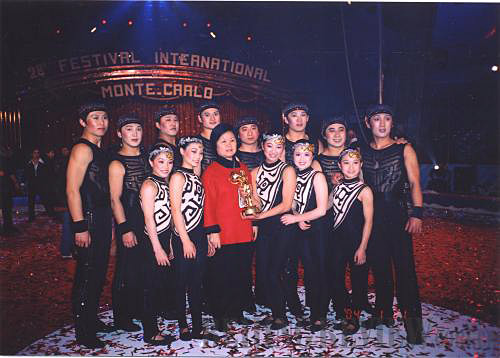|
 |
|
TOP AWARD: Sun Lili and her students after they won the Golden Clown Award at the International Circus Festival of Monte-Carlo in 2004 (COURTESY OF CHINA NATIONAL ACROBATIC TROUPE) |
October 20 this year marked the 60th anniversary of the China National Acrobatic Troupe (CNAT). The grand performance, A Family Letter, was held at the Great Hall of the People on October 19 and 20 to celebrate the occasion. The performance, a spectacular award-winning show, depicted the letter of a young acrobatic student to his mother, telling the story of how the nameless acrobatic trainee grew up to be an outstanding artist.
The director He Xiaobin said through the celebrative performance the art troupe hopes to express its gratitude to society's support in the past 60 years.
Tradition
Chinese acrobatics has been in existence for nearly 3,000 years because of the tradition of passing feats from a master to students continuing to challenge performers' limits. In this tradition, students greatly respect their masters, and try their best to preserve and to do everything possible to pass the traditions down.
Before the founding of the People's Republic in 1949, the acrobatic arts were inherited in a way of oral instruction among family members, as well as between masters and students. When teaching acrobatic skills, the virtues of the older-generation artists were also passed to their successors.
On September 10, 1954, CNAT enrolled its first students. Since then, the tradition of family teaching model has been replaced by a new training form.
CNAT invited its outstanding acrobats and dance experts from the former Soviet Union to give specialized training for more than 30 students from all around the country.
CNAT also sent excellent acrobats to other places in the country, helping local acrobatic circle improve their training and giving them strong support in the aspects of scripting, costumes, props and music.
"In the past, traditional Chinese acrobats had great limitations in teaching methods. The feats of an apprentice depended on and were limited to his master's skills. Besides this, because of the lack of scientific teaching methods, the old way of training sometimes went against young acrobats' development of skill," said Li Yannian, an expert on acrobatics.
The efforts to modernize the acrobat training system have brought about several schools for this purpose across China.
In 1999, the Beijing International Arts School (BIAS) was set up, the first school of acrobatics in Beijing, also the first school to specialize in training acrobatic talents.
Dedication
In 1995, 45-year-old acrobat Sun Lili, who was a popular star of acrobatics at that time, was given a new task: teaching at the newly founded Acrobatic Circus Department of the Beijing Art School (predecessor of BIAS). But that meant she had to give up performing on stage since then.
Sun's 60 or so students were from 5 to 10 years old. It was really a great challenge for Sun to teach the children. At first, almost all of them could not bear the hard training and missed their homes. Sun gave them rigorous training in basic skills while providing encouragement.
Basic skill training can be boring, especially for those at this age level. But, generally speaking, basic skills should be inculcated at a young age, or the opportunity may be lost for training to be the best, said Sun.
"Acrobatics is a kind of art. Acrobatic training requires efforts beyond the ordinary," Sun tells her students. "Art itself is linked to bitterness and difficulty. You can't enjoy the pleasure of art without hard training."
Her students later understand her and fondly call her "Mother Sun." In her eyes, "daring to endure hardship" is a fundamental quality of an acrobat.
| 